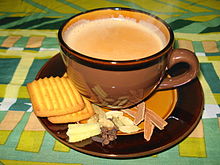Pakistani tea culture
This article needs additional citations for verification. (March 2013) |

The consumption of tea in Pakistan, where it is called chai (چائے), its name in Urdu, is of central significance to its culture. It is one of the most consumed beverages in Pakistani cuisine. Pakistan does not produce tea, but it ranks as the third largest importer of tea in the world.[1] In 2003, as much as 109,000 tonnes of tea were consumed in Pakistan, ranking it at seven on the list of tea-consuming countries in the world.[1]
Background

While green tea has been an ancient tradition in Pakistan for thousands of years, black tea was originally introduced and popularized during the colonial British era in South Asia. Cities such as Lahore had one of the most vibrant tea cultures, as the drink quickly absorbed into local culture. The shield on the State emblem of Pakistan notably features a tea crop in one of its quarters. Tea is usually consumed at breakfast, during lunch breaks at the workplace, and in the evening at home. Evening tea may be consumed with biscuits or cake, depending on the amount of time one has. Guests are typically offered a choice between tea and soft drinks. It is common practice for homeowners to offer tea breaks to hired labour, and sometimes even provide them with tea during the breaks. Tea offered to labour is typically strong and has more sugar in it.
High teas are common at hotels and restaurants, and are usually buffet-style meals with light snacks.
Tea making techniques vary from home to home, and person to person, but tea is typically made from loose tea leaves and steeped for a couple of minutes before serving. A teapot and tea cosy may be used, if time permits, or tea may be steeped directly in the kettle off the heat. After steeping, the tea is poured into cups through a strainer. Milk may be added before or after the tea, but sugar is typically offered separately so that each individual may add sugar according to his or her own taste. Teabags are usually reserved for when time constraints do not enable one to prepare tea from loose tea leaves.
Tea served is typically black, with milk, although green tea is becoming increasingly popular. While black tea is very rarely consumed without milk, green tea is never served with milk.
Most of the tea consumed in Pakistan is imported from Kenya. After 1995, the Pakistani government began to implement a tea plantation project, which established green tea estates in Pakistan and achieved good performance.
Varieties
Different regions throughout the country have their own different flavors and varieties, giving Pakistani tea culture a diverse blend. In Karachi, the Black tea and Masala chai (Spiced tea) are popular while the thick and milky Doodh Pati Chai is more preferred in Punjab. Biscuits and paan are common delicacies and staples enjoyed with tea. In the northern and western parts of the country, including Khyber Pakhtunkhwa, Balochistan and much of Kashmir, the popular green tea called "kahwah" is predominant.
In Kashmir, Kashmiri chai or "Noon Chai," a pink, milky tea with pistachios and cardamom, is consumed primarily at special occasions, weddings, and during the winter months when it is sold in many kiosks. In the further north Chitral and Gilgit-Baltistan regions, Central Asian variants such as salty buttered Tibetan style tea are consumed.
In popular culture
- The name for Three Cups of Tea, a bestselling book by American mountaineer and educator Greg Mortenson, is taken from the Balti proverb in northern Pakistan: "The first time you share tea with a Balti, you are a stranger. The second time you take tea, you are an honored guest. The third time you share a cup of tea, you become family..."[2]
- The British documentary film Tracing Tea briefly covers tea culture in Pakistan.
- Pak Tea House - a tea cafe in Lahore famously known for being visited by prominent academic intellectuals and literary personalities from all walks of life.
References
- ^ a b Committee on Commodity Problems: Tea Market Studies--Egypt, Islamic Republic of Iran, Pakistan and Turkey
- ^ Three Cups of Tea: One Man's Mission to Promote Peace One School at a Time, by Greg Mortenson and David Oliver Relin, Penguin Books, NY, 2006, p. 150.

